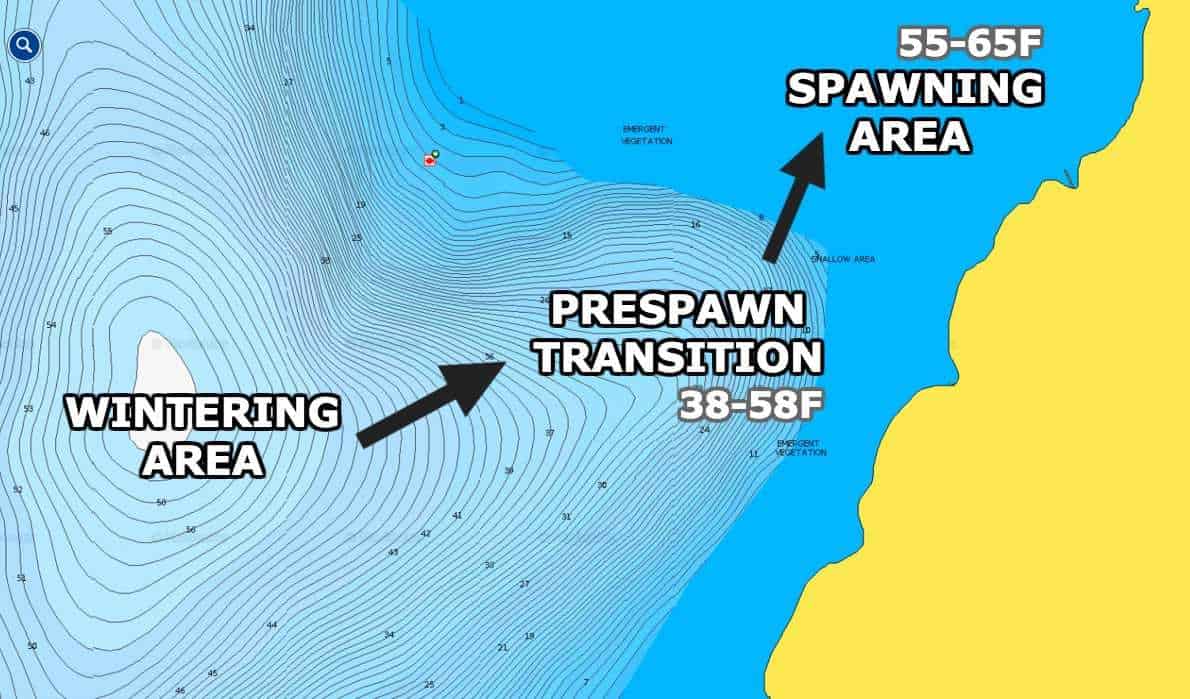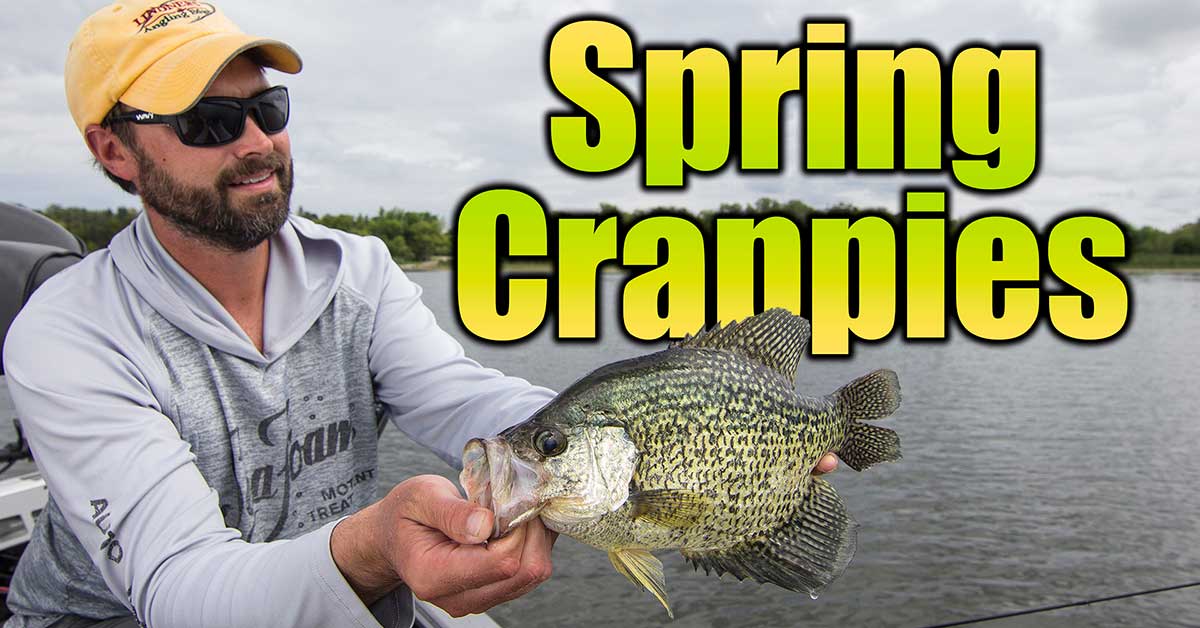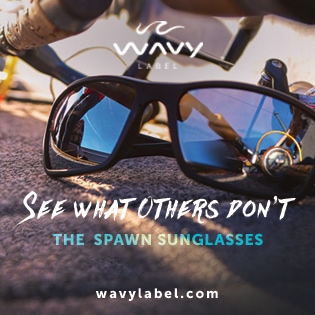Spring Crappies: Key Locations & Strategies
Spring crappies are on the top of many people’s list in the spring. In fact, panfish continually rank as one of the most commonly targeted species in the U.S., and in northern waters, their popularity exceeds that of even largemouth and smallmouth bass.
If panfish are popular, then crappies are the undisputed heavyweight champion of the group. They have become increasingly sought after nationwide as new people are introduced to the fun and table-fare they provide. Their appeal is simple, especially in spring as their availability is widespread, and they are attainable by anglers of many means, ages, and skill levels.
Fishing for spring crappies can be basic yet enjoyable as they fill spawning grounds in the shallows and provide some excellent angling well into the late spring period. That said, there are some details that will make certain anglers more successful than others, and those specifics relate heavily to what seasonal movements and weather do to affect everything from their location to the presentations we use.
Weather and the Cold-Water Effect on Spring Crappies
Generally speaking, most spring weather patterns are highly variable as morning moisture evaporates and takes shape as clouds across our lakes areas. Rain and wind events can settle in for days at a time, also providing a great deal of dynamic change for spring crappies carrying out their spring rituals. With that said, water temperature is a primary variable and bellwether to movements and the bite.
Early on, just after ice-out in northern lakes and as the water warms south of the ice-belt, the cold-water effect lingers with overall diminished crappie activity in the morning, and a later afternoon flurry as water temps climb 5 degrees or more in the shallows within the same day.
Increased sun angle gives way to more actively biting fish the longer that the sun shines onto rocks, sand, or shallow black-bottom bays, thus driving fish closer and closer to the shallow water spawning grounds they traditionally utilize.
Depending on your neck of the woods and how the spring season shapes up, crappies will usually stage to spawn and dump eggs in that 55-65 degree water temperature range. That said, anytime water temps stabilize and maintain consistent 50-degree temps, you can expect to find crappies roaming the shallows in good numbers.
Location, Location, Location
Water temperatures are the primary driver of spawning (and catching) locations, as fish favor those areas that warm first and hold that temperature well, but to find crappies consistently, a little knowledge from the winter seasons can go a long way. I start with mid-winter community holes that anglers frequent to find schooled up groups of crappies over depth.
These areas can be in 50FOW or more, but in most instances, you can draw a nearly straight line from these holes, to pre-spawn staging areas, and the eventual spawning shallows.
Think of this line as a continuum of depth from which to search along. Start deeper, and move to shallower staging areas like a weedline or edge of a flat in 10-12FOW, then move all the way up to the shallows beyond, shallower than 6-8FOW.
The best areas have a well-defined basin, that gives way to an inside turn or “chute” that fish follow back and forth as water temperatures and weather changes. Animals of all kinds are well known for using topographic funnels and land contours for movement, and fish are no exception. Underwater topography concentrates movement, making inside turns and the inward directions that point towards the shallows great locations to start.

On cooler, overcast or rainy days within the spring period, consider following this line outward to the depths. On the warmer days, focus your efforts shallower for spring crappies, knowing again that activity will be better from the middle to late part of the day, especially in the earlier part of the spring season. Proceed slowly with the bow-mount down, using your electronics as a key part of this fish-finding session. If you have side-imaging, make sure to use it as this technology is tailor-made for locating big schools of early season panfish.
As far as the spawning locations themselves, you’re looking for back bays, coves, and boat canals with warmer than main-lake water temperatures. That said, there will be zones within these warmer locations that fish congregate in more heavily.
That can be docks, brush piles, bulrushes, pencil-reeds, and lily pad root stems where only soft-bottom is available. Cover however is secondary to water temperature, so keep that in mind. Lastly, know that spawning location depth is relative for the lake you’re fishing and its clarity. Fish in clear water can spawn well outside of the reedbeds in 6FOW or more, while murky-water fish can be right up against the bank.
Spring Crappie Presentations – Speed Decisions
Now that you’ve found them, effort can go into catching them, but it’s good to pause a bit before you start slinging any old jig. Decipher an approach based on speed first and foremost, taking careful account of the time of year and water temperature, along with time of day, and what you see on your electronics. If earlier, and fish are tightly schooled on pre-spawn transition flats and edges, you’ll want to fish slower than if it were later in the day, season, or otherwise warmer and fish are more spread out.
It’s hard to beat a bobber for crappies in that regard, as stationary targets presented in the right locations are hard for these fish to ignore, sometimes regardless of what bait or lure is tied on the business end of the line.
Simple jigs and minnows early season under a slip bobber are deadly, and eventually, give way to tubes and hair jigs both with and without minnows as fish slip into the spawn. Towards the tail end of the spring spawn and during warm afternoons, slowly retrieved jig and plastic combinations become the most efficient and effective means to cover water, catch fish, and target more aggressive crappies.
Push your way along slowly, from shallow to deep, knowing that your boat control can both cost and reap dividends depending how you drive. Especially in shallow water zones in that 2-4FOW range, any water clarity makes it imperative not to drive all over the areas you intend to fish. Start at the edges and pick your way in, making long casts to discover new pods of fish as you go.
Gear Up for Spring Crappies
The right line will play a role here, especially in heavy cover. Nanobraid varieties have found a niche in clear-water environments where long casts are the order of the day, and I can think of few better roles for that silky-slick line type than spring crappies. Especially in cover, fish fearlessly near brush and snags, knowing you can straighten out a hook if needed. Traditional monofilament still has a place, but do yourself a favor and re-spool with new line to avoid the annoyance of memory-laden line from last season.

Pairing up with the right rod will make even more of a difference, as most anglers fish for panfish with short, whippy rods in general. Varieties that extend 7’ or more cast small jigs and baits much further, especially when paired with light mono or nano-line varieties. With that much line out, it’s good to have a faster action rod than the noodle-type Ultra-lights so common for panfishing today.
Faster actions get your hookset to the powerful part of the blank faster, meaning you’ll have to make the rod travel back less distance to impart a hookset, helping both to quicken up the hookset and keep big panfish buttoned-up in heavy cover.
Giving Back
With great knowledge comes a responsibility to the resource, such that ethically I’d have a dilemma in discussing spawning crappies without offering some advice as to the importance of selective harvest. When it comes to our panfish resources, overall size and quality fisheries are becoming more scarce than ever.
As better educated anglers with more technology strive to catch more fish, only the most remote or otherwise out-of-the-way locations offer the consistent quality catches of yesteryear. That’s a trend supported statistically throughout every region of North America with panfish, and is a topic for concern amongst many fisheries managers.
The good news is that you can catch your panfish and eat them too if you follow some hard-won and evidence-based approaches to keeping spring crappies:
Selective Harvest – Late-ice congregations of panfish in the north, and shallow spawning bites nationwide represent intense periods of vulnerability. During these times, the biggest panfish in the system are easy targets and readily exposed.
Spread the Love – As anglers, we’re opportunists. It’s difficult to leave a lake that has a great bite for another, but keeping any number of fillets from 10 lakes is far better than that same number of fish from 1 lake. What I’ve found is that you can often find better fishing on nearby water bodies, distribute your take, and enjoy the hunt for new spots along the way.
Measure Everything – It’s hard to know what a big fish is without a good bump board. Get used to measuring your panfish and get a feel for what a good crappie really is where you live. Consider releasing fish over 11-12”es voluntarily, depending on the abundance and quality of the fishery you’re on.
Avoid High-Grading – Big crappies, especially in the north, are old fish and top-performing individuals of their species. Keeping only the fittest members of any population leaves an unnecessarily shallow gene pool, a foul which is especially damaging to the increasingly few small, remote lakes where great panfishing can still be found. Tiny lakes simply can’t withstand the same pressure as larger ones, even from small numbers of anglers.
Fresh Only Please – Start with a plan as to how many fish you’d like to eat for an upcoming meal and stick to it. Freeze if you need to, but again, have a plan in the nearby future to consume them. Continual limit-fishing and freezer-filling far too often leads to freezer-burnt fish that are tossed out. Knowing what you want, catching that many, and throwing back the rest prevents those marathon cleaning sessions and promotes a sustainable catch and keep mentality.
Fish as a Treat – As far as the resource is concerned, gone are the days of serving nothing but bottomless baskets of fish. Round out any meal with some complimentary side dishes that don’t hide or cover up the main event, and you’ll find that the same fish go a lot further.
Do As I Say, AND as I do – Always remember that the younger generations are looking towards you and your behavior. Parents, grandparents, uncles, aunts, and cousins, make sure you pass along the right attitudes and make them healthy habits.
Keep it Fun
Chances are, you started your fishing career targeting panfish, fishing then very similar to how you are now for these same fish. It’s a great time of year to bring kids or people without much fishing experience out on the lake to enjoy one of the best bites of the year. For you walleye and bass anglers, don’t hesitate to switch over to some shallow spring crappies early!











